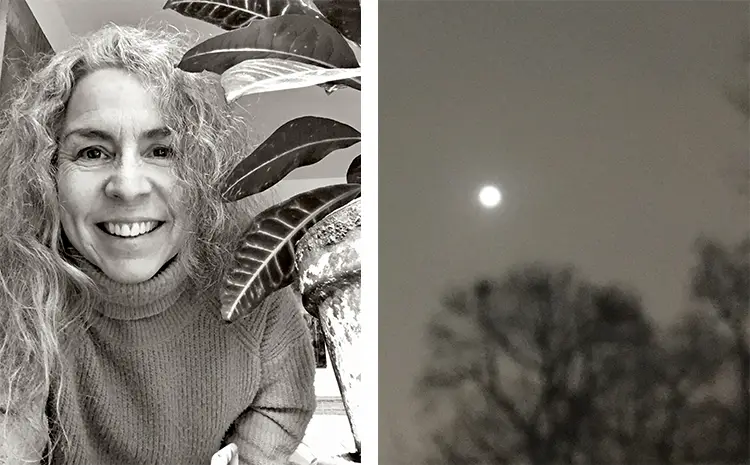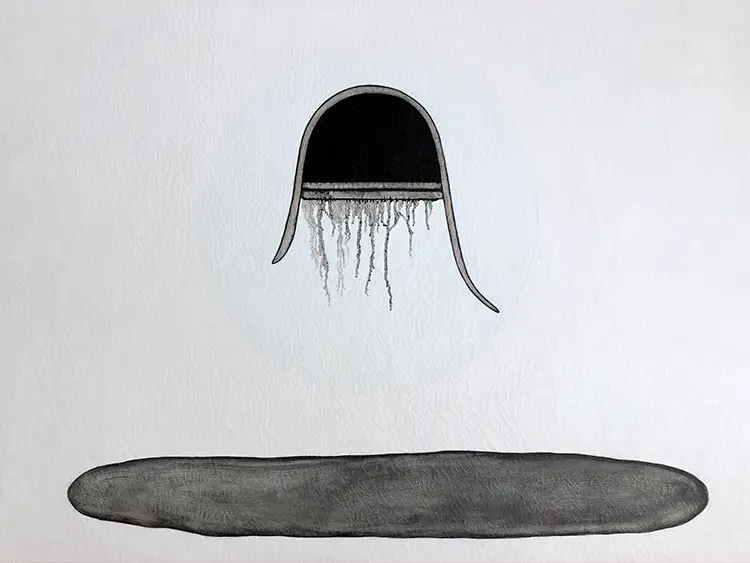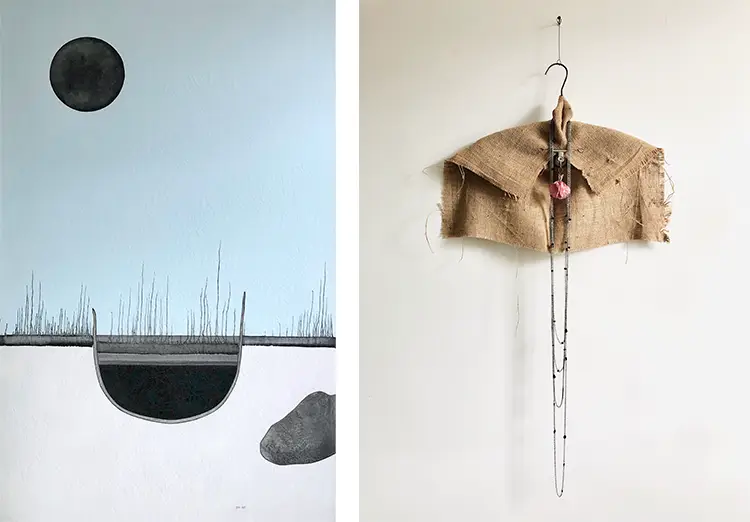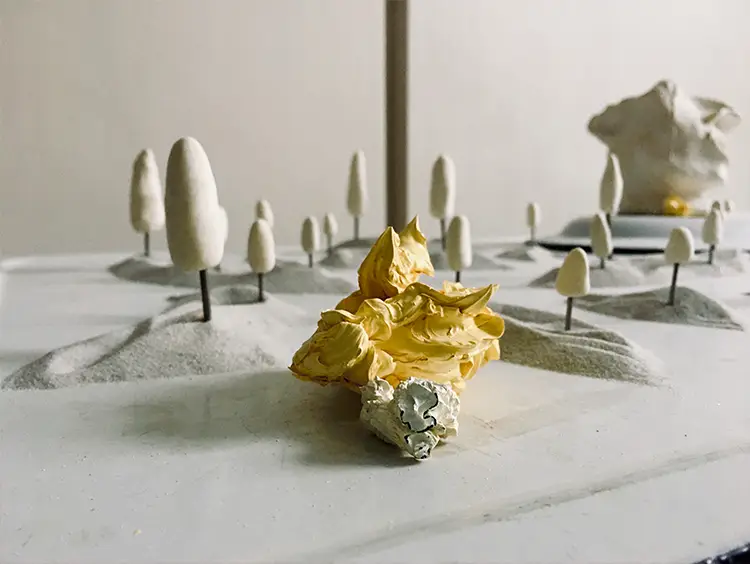“I try to glimpse imperfection, detail, to listen to silence and natural sounds.”
Unearthed Beginnings: From Ormstown to Multidisciplinary Creation
Anne-Marie Giroux’s artistic journey originates in Ormstown, Quebec, and stretches outward like the many branches of her creative practice. Raised in a home that breathed music, literature, and movement, she found herself deeply shaped by her parents’ dual passions. Her mother, a classically trained pianist, and her father, a psychoeducator with a strong affinity for woodworking, cultivated an environment where curiosity was encouraged. Long hours spent observing her father in his workshop nurtured her fascination with objects, tools, and the tactile world. But it was the death of her father when she was just ten that marked a formative turning point—one that introduced themes of transience, presence, and time into her consciousness, all of which would later emerge in her artistic vocabulary.
Relocating to Montreal at sixteen placed Giroux at the heart of a vibrant artistic scene. Her creative instincts first found structure through formal education in the arts. Initially drawn to film photography during college, she quickly expanded her practice, exploring drawing, theater studies, painting, sculpture, dance, and cinema. This educational path culminated in a Bachelor of Fine Arts from Concordia University. Each discipline added a new dimension to her understanding of material, movement, and expression. The multidisciplinary nature of her training became foundational, shaping not only how she thought but also how she constructed her work—often building connections between physical presence, emotion, and space.
This multidimensional approach was central to her early career. For over a decade, Giroux created complex choreographic performances that synthesized contemporary dance, sculpture, film, video, and sound within the same physical space. Eventually, her practice shifted toward visual arts, but the desire to intertwine bodily sensation with materials never waned. Her artistic trajectory continued to revolve around bridging gaps—between movement and stillness, between tangible objects and invisible emotions. This hybrid nature remains at the core of her work, which has evolved to include painting, sculpture, and immersive installations while never fully abandoning the echoes of choreography and sensory memory that shaped her early practice.

Anne-Marie Giroux: Where Object Meets Emotion, and Movement Pauses
At the center of Giroux’s artistic philosophy lies a dialogue between materiality and presence. She employs both conventional media—oil, lacquer, tar, graphite, plaster, cement—and salvaged or recycled materials to construct works that explore emotional depth and existential questions. Whether she is working on paper, wood, canvas, or building three-dimensional forms, she engages materials intuitively, often beginning with poetic writing as a precursor to her visual inquiries. This layered, process-oriented approach allows her to peel back superficial surfaces, arriving at the raw intersections between form and feeling.
Stylistically, her work defies strict categorization. Giroux moves fluidly between abstraction and figuration, minimalism and conceptualism, depending on the emotional or philosophical territory she is exploring. Her creative compass points toward questions surrounding impermanence, decay, memory, and renewal. The physical properties of her chosen materials often mirror these themes—the brittleness of plaster, the weight of cement, the decay inherent in repurposed objects. Through this lens, Giroux investigates what it means to be alive, to lose, to endure, and to carry traces of others within oneself. Her emphasis on the ephemeral and the incomplete invites viewers to confront the fragments and silences that often define human experience.
Her newest installation project, NOCTURNES, serves as a poignant synthesis of these recurring motifs. Scheduled for exhibition in Montreal in autumn 2025, the work navigates themes of grief, memory, and nocturnal introspection. Divided into three distinct phases—individual mourning, nocturnal luminosity, and collective mourning—NOCTURNES uses soundscapes, visual compositions, and textual fragments to construct a poetic environment. Especially notable is Giroux’s use of moon imagery, which she has been photographing since 2019. The installation culminates in a vision of a futuristic synthetic forest—a metaphorical contemplation of what may remain once nature itself has vanished. This ambitious project exemplifies her unique ability to harness the weight of absence and transform it into a tangible, immersive presence.

Material Language and the Poetics of the Unfinished
In Giroux’s creative world, materials are not passive carriers of form—they are agents of meaning. Her engagement with matter is rooted in tactile intuition, informed by the tension between construction and collapse, visibility and erasure. By incorporating found objects and degraded materials, she reactivates what has been discarded, inviting viewers to consider how memory, time, and entropy shape both art and existence. Her works are not polished declarations but open-ended conversations, allowing space for silence, shadow, and ambiguity. This emphasis on imperfection and rawness brings a human vulnerability to her pieces, reinforcing the notion that art can function as both witness and vessel.
The interplay between movement and stillness remains a critical undercurrent in her work. While she no longer choreographs in the traditional sense, traces of kinetic energy inhabit her sculptures and installations. The gestures embedded in brushstrokes, the balance between opposing textures, and the spatial relationships within her compositions all hint at motion paused, at moments suspended in flux. It’s an echo of her background in dance and performance, where the body’s position in space becomes a language of its own. Even when working with inert materials, Giroux imbues them with a sense of breath, of tension that anticipates release.
Equally significant is her method of beginning projects through poetic expression. Before matter takes shape visually, it takes root in language. These fragments of text act as blueprints—not for literal translation but for emotional and thematic resonance. This interlacing of poetry and visual art amplifies the atmospheric weight of her installations. The result is a body of work that refuses to settle, always hovering at the edge of articulation. Through her process, Giroux encourages viewers to embrace uncertainty and to find beauty not in resolution, but in presence—the kind that lingers long after form has faded.

Anne-Marie Giroux: Expanding the Horizon of Collective Artistry
For Giroux, creation has always been more than an individual act; it’s a process she imagines as deeply relational and expansive. Her longstanding dream to co-create a permanent, international public artwork in collaboration with artists from various countries reflects this vision. Such a collective endeavor would embody her belief in shared authorship and artistic pluralism. Bringing together voices from different cultural and aesthetic backgrounds would allow for a dialogue that transcends geography and language—a convergence of sensibilities that reflects the interconnectedness of the human experience.
Her influences speak to this broad-reaching sensibility. Composer John Cage and choreographers like Merce Cunningham, Jean-Pierre Perreault, and Min Tanaka shaped her understanding of rhythm, unpredictability, and bodily expression. Visual artists such as Eva Hesse and Marcel Duchamp informed her experimental use of materials, while figures like Mark Rothko, Agnès Martin, and Jean-Michel Basquiat revealed the emotional and spiritual potential of abstraction and mark-making. Yves Klein and Ernst Ludwig Kirchner brought further dimensions of performance, color, and psychological intensity to her conceptual framework. Each of these figures contributes to a mosaic of influence that is as diverse as her practice.
This wide-reaching inspiration reinforces her ability to move seamlessly across disciplines and mediums. Yet, despite the multiplicity of her references and techniques, Giroux remains anchored in a singular purpose: to create spaces—both physical and emotional—where viewers can engage with absence, memory, and transformation. Her art asks not for interpretation, but for presence; not for answers, but for attention. Whether she is conjuring a moonlit forest of lost futures or repurposing fragments of forgotten materials, Anne-Marie Giroux offers an art that speaks not only to the eye, but to the sensate body, to shared grief, and to the enduring pulse of the living.








